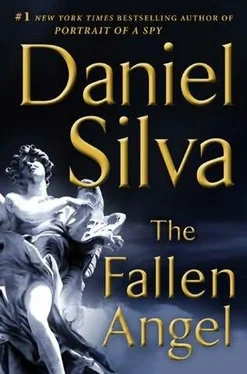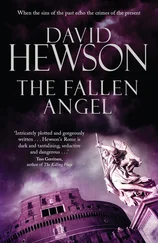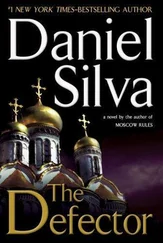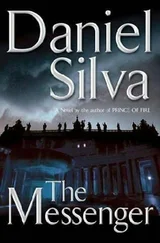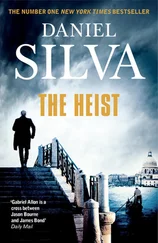He removed his leather jacket and switched on a pair of standing halogen lamps. The Deposition of Christ , widely regarded as Caravaggio’s finest painting, glowed under the intense white light. Gabriel stood motionless before the towering canvas for several minutes, hand pressed to his chin, head tilted to one side, eyes fixed on the haunting image. Nicodemus, muscular and barefoot, stared directly back as he carefully lowered the pale, lifeless body of Christ toward the slab of funerary stone where it would be prepared for entombment. Next to Nicodemus was John the Evangelist, who, in his desperation to touch his beloved teacher one last time, had inadvertently opened the wound in the Savior’s side. Watching silently over them were the Madonna and the Magdalene, their heads bowed, while Mary of Cleophas raised her arms toward the heavens in lamentation. It was a work of both immense sorrow and tenderness, made more striking by Caravaggio’s revolutionary use of light. Even Gabriel, who had been toiling over the painting for weeks, always felt as though he were intruding on a heartbreaking moment of private anguish.
The painting had darkened with age, particularly along the left side of the canvas where the entrance of the tomb had once been clearly visible. There were some in the Italian art establishment—including Giacomo Benedetti, the famed Caravaggisto from the Istituto Centrale per il Restauro—who wondered whether the tomb should be returned to prominence. Benedetti had been forced to share his opinion with a reporter from La Repubblica because the restorer chosen for the project had, for inexplicable reasons, failed to seek his advice before commencing work. What’s more, Benedetti found it disheartening that the museum had refused to make public the restorer’s identity. For many days, the papers had bristled with familiar calls for the Vatican to lift the veil of silence. How was it possible, they fumed, that a national treasure like The Deposition could be entrusted to a man with no name? The tempest, such as it was, finally ended when Antonio Calvesi, the Vatican’s chief conservator, acknowledged that the man in question had impeccable credentials, including two masterful restorations for the Holy See—Reni’s Crucifixion of St. Peter and Poussin’s Martyrdom of St. Erasmus . Calvesi neglected to mention that both projects, conducted at a remote Umbrian villa, had been delayed due to operations the restorer had carried out for the secret intelligence service of the State of Israel.
Gabriel had hoped to restore the Caravaggio in seclusion as well, but Calvesi’s decree that the painting never leave the Vatican had left him with no choice but to work inside the lab, surrounded by the permanent staff. He was the subject of intense curiosity, but then, that was to be expected. For many years, they had believed him to be an unusually gifted if temperamental restorer named Mario Delvecchio, only to learn that he was something quite different. But if they felt betrayed, they gave no sign of it. Indeed, for the most part, they treated him with a tenderness that came naturally to those who care for damaged objects. They were quiet in his presence, mindful to a point of his obvious need for privacy, and were careful not to look too long into his eyes, as if they feared what they might find there. On those rare occasions when they addressed him, their remarks were limited mainly to pleasantries and art. And when office banter turned to the politics of the Middle East, they respectfully muted their criticism of the country of his birth. Only Enrico Bacci, who had lobbied intensely for the Caravaggio restoration, objected to Gabriel’s presence on moral grounds. He referred to the black curtain as “the Separation Fence” and adhered a “Free Palestine” poster to the wall of his tiny office.
Gabriel poured a tiny pool of Mowolith 20 medium onto his palette, added a few granules of dry pigment, and thinned the mixture with Arcosolve until it reached the desired consistency and intensity. Then he slipped on a magnifying visor and focused his gaze on the right hand of Christ. It hung in the manner of Michelangelo’s Pietà, with the fingers pointing allegorically toward the corner of the funerary stone. For several days, Gabriel had been attempting to repair a series of abrasions along the knuckles. He was not the first artist to struggle over the composition; Caravaggio himself had painted five other versions before finally completing the painting in 1604. Unlike his previous commission—a depiction of the Virgin’s death so controversial it was eventually removed from the church of Santa Maria della Scala— The Deposition was instantly hailed as a masterwork, and its reputation quickly spread throughout Europe. In 1797, the painting caught the eye of Napoléon Bonaparte, one of history’s greatest looters of art and antiquities, and it was carted over the Alps to Paris. It remained there until 1817, when it was returned to the custody of the papacy and hung in the Vatican.
For several hours, Gabriel had the lab to himself. Then, at the thoroughly Roman hour of ten, he heard the snap of the automatic locks, followed by Enrico Bacci’s lumbering plod. Next came Donatella Ricci, an Early Renaissance expert who whispered soothingly to the paintings in her care. After that it was Tommaso Antonelli, one of the stars of the Sistine Chapel restoration, who always tiptoed around the lab in his crepe-soled shoes with the stealth of a night thief.
Finally, at half past ten, Gabriel heard the distinctive tap of Antonio Calvesi’s handmade shoes over the linoleum floor. A few seconds later, Calvesi came whirling through the black curtain like a matador. With his disheveled forelock and perpetually loosened necktie, he had the air of a man who was running late for an appointment he would rather not keep. He settled himself atop a tall stool and nibbled thoughtfully at the stem of his reading glasses while inspecting Gabriel’s work.
“Not bad,” Calvesi said with genuine admiration. “Did you do that on your own, or did Caravaggio drop by to handle the inpainting himself?”
“I asked for his help,” Gabriel replied, “but he was unavailable.”
“Really? Where was he?”
“Back in prison at Tor di Nona. Apparently, he was roaming the Campo Marzio with a sword.”
“Again?” Calvesi leaned closer to the canvas. “If I were you, I’d consider replacing those lines of craquelure along the index finger.”
Gabriel raised his magnifying visor and offered Calvesi the palette. The Italian responded with a conciliatory smile. He was a gifted restorer in his own right—indeed, in their youth, the two men had been rivals—but it had been many years since he had actually applied a brush to canvas. These days, Calvesi spent most of his time pursuing money. For all its earthly riches, the Vatican was forced to rely on the kindness of strangers to care for its extraordinary collection of art and antiquities. Gabriel’s paltry stipend was a fraction of what he earned for a private restoration. It was, however, a small price to pay for the once-in-a-lifetime opportunity to clean a painting like The Deposition .
“Any chance you might actually finish it sometime soon?” Calvesi asked. “I’d like to have it back in the gallery for Holy Week.”
“When does it fall this year?”
“I’ll pretend I didn’t hear that.” Calvesi picked absently through the contents of Gabriel’s trolley.
“Something on your mind, Antonio?”
“One of our most important patrons is dropping by the museum tomorrow. An American. Very deep pockets. The kind of pockets that keep this place functioning.”
“And?”
“He’s asked to see the Caravaggio. In fact, he was wondering whether someone might be willing to give him a brief lecture on the restoration.”
Читать дальше
Конец ознакомительного отрывка
Купить книгу
